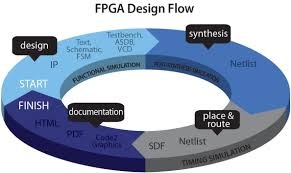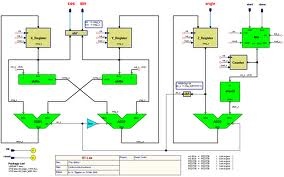HDL Based Modeling and Designing
- Goal
This lab exercise is formulated to familiarize the students with different IDE and ISE tools for HDL based designing.
- Equipment Required:
• A Computer
• Xilinx ISE
1070_fa_rszd.jpg)
_fa_rszd.jpg)
• ModelSim
1897_fa_rszd.jpg)
1400_fa_rszd.jpg)
- Abstraction:
Hardware Description Language is a language from a class of computer languages or modeling languages for brief description and designing of electronic circuits, and most-commonly, digital logic. It can describe the circuit's operation, its design and tests to verify its operation by means of simulation. The most popular HDLs are
- Verilog
- VHDL
Verilog due to its similarity to C language is easier to understand so has
become most widely used HDL in educational institutions.

6265_fa_rszd.jpg)
- Design Methods
Two basic types of digital design methodologies:
a top-down design methodology
and
a bottom-up design methodology.
In top-down design methodology, we define the top-level block and identify the sub blocks necessary to build the top-level block. We further subdivide the sub-blocks until we come to leaf cells, which are the cells that cannot further be divided .

In bottom -up design methodology, we first identify the building blocks that are available to us. We build bigger cells, using these building blocks. These cells are then used for high-level blocks until we build the top-level block in the design.
- A Module:
A module is the basic building block in Verilog. A module can be an element or a collection of low-level design blocks.
In Verilog, a corresponding keyword , endmodule, must appear at the end of the module definition.
Each module must have a module_name, which is the identifier for the module, and a module_terminal_list, which describes the input and output terminals of the module.
module <module_name> (<module_parmeter_list>);
<module internals>
endmodule
- Conventions:
The basic lexical conventions used by Verilog HDL are similar to those in the C programming
Tokens can be comments, delimiters, numbers, strings, identifiers, and keywords. Verilog HDL is a case-sensitive language. All keywords are in
- Whitespace
Blank spaces , tabs and newlines comprise the whitespace. Whitespace is ignored by Verilog . Whitespace is not ignored in string.
- Comments
Comments can be inserted in the code for readability and documentation. There are two ways to write comments. A one-line comment starts with "//". Verilog skips from that point to the end of line. A multiple-line comment starts with "/*" and ends with "*/". Multiple-line comments cannot be inserted. However, one-line comments can be embedded in multiple-line comments.
// a one-line comment
/* a multiple line
comment */
- Operators:
Operators are of three types:
unary, binary,
and ternary.
Unary operators preceede the operand.
Binary operators appear between two operands. Ternary operators have two separate operators that separate three operands.
a = ~ b; b is the operand
a = b && c; a = b ? c : d; 3.3.4 Number Specification
There are two types of number specification in Verilog: sized and unsized.
a) Size numbers
Sized numbers are represented as size '<base format> <number>.
size is written only in decimal and specifies the number of bits in the number. Legal base formats are decimal ('a or 'A), hexadecimal ('h or 'H), binary ('b or 'B) and octal ('o o r 'O). The number is specified as consecutive digits from 0, 1, 2, 3, … , a, b, c, d, e, f. Only a subset of these digits is legal for a particular base. Uppercase letters are legal for number specification.
4'b1111
12'habc
16'd255
b) Unsized numbers
Numbers that are specified without a <base format> specification are decimal numbers by default.
Numbers that are written without a <size> specification have a default number of bits that is
simulator- and machine-specific (must be at least 32).
2345
6'hc
3'o21
- String
A string is sequence of characters that are enclosed by double quote. The restriction on a string is that it must be contained on a single line, that is, without a carriage return. It cannot be on multiple lines. Strings are treated as a sequence of one-byte ASCII values.
"Hello World"
- Identifiers and Keywords
Keywords are special identifier reserved to define the language construct. Keywords are in lowercase. Identifiers are objects so that they can be referenced in the design. Identifiers are made up of alphanumeric characters, the underscore , or the dollar sign. Identifiers are case sensitive. Identifiers start with an alphabetic character or an underscore. They cannot start with a digit or a $ sign.
reg value;
input clk;



